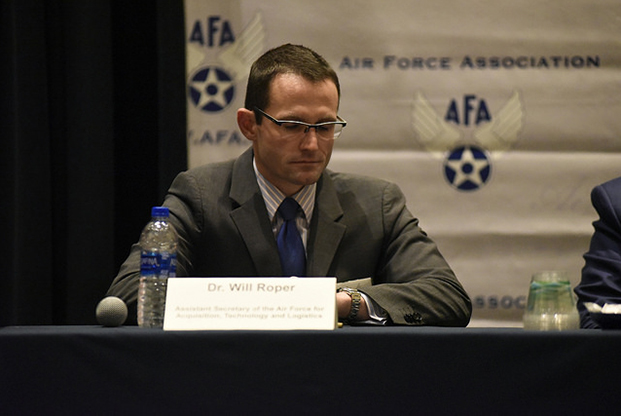
USAF acquisition chief Will Roper, shown here on a panel at AFA's 2018 Air, Space & Cyber Conference in National Harbor, Md., discussed the Hypersonic Conventional Strike Weapon during a media roundtable during the conference. Staff photo by Mike Tsukamoto.
Air Force acquisition chief Will Roper told reporters he thinks the Hypersonic Conventional Strike Weapon (HCSW) could go operational in the 2020 timeframe, but that it will be a basic system the service will buy in only limited quantities. USAF will likely buy a full inventory later, after “spiral” improvements have added desirable additional features.
Speaking with reporters at AFA’s Air, Space & Cyber Conference, Roper said that of all the services that are pursuing hypersonic weapons, USAF “has the easiest path to fielding.” The initial version of the weapon will likely be carried by a B-52, which he said is “very forgiving” in terms of the size of munitions. The system won’t have to be miniaturized, he said, or shrunk to fit a small volume.
The HCSW will build on something Roper worked at when he was at the Strategic Capabilities Office, or SCO, and that was the conventional prompt strike effort, he said.
“Taking the technology out of the prompt strike program, adding to it some booster work and integration work that SCO is doing, and adding that to our HCSW program” has allowed the service to “accelerate” hypersonics fielding, he said. “It’s embracing ‘not invented here’” by taking advantage of work done by the Army and Navy “and just taking the fastest path to the goal line with the technologies that exist.”
Assuming the program progresses as expected, he said the current planned Initial Operational Capability would come “at the end of calendar year ‘20.” However, “that’s probably not going to be the real IOC date because it’s a hypersonic weapons program and you would expect that we would need to go test aggressively. But the fact that we can compress the development into two years … says that we’re finally going to get on a path to do this in our lifetime.”
Roper said the initial version will provide a basic capability only, and “I suspect this will be a classic spiral development program where you’ll go into some low rate of production, then keep spiraling the technology until you get enough bells and whistles on the weapon and you say, ‘that’s the one I want to buy.’” Too many programs have failed because of attempts to load up the initial version with too many technological advances, “creating concurrent risk,” he said. “We’re trying not to do this” on hypersonics.
The Air Force is “out of the starting gates the fastest” of all the services, “so I think we’ll IOC the fastest,” Roper said, adding that the technologies USAF develops will benefit the Army and Navy efforts as well.